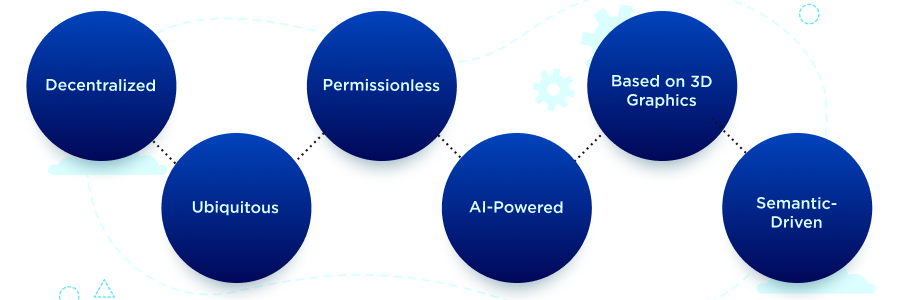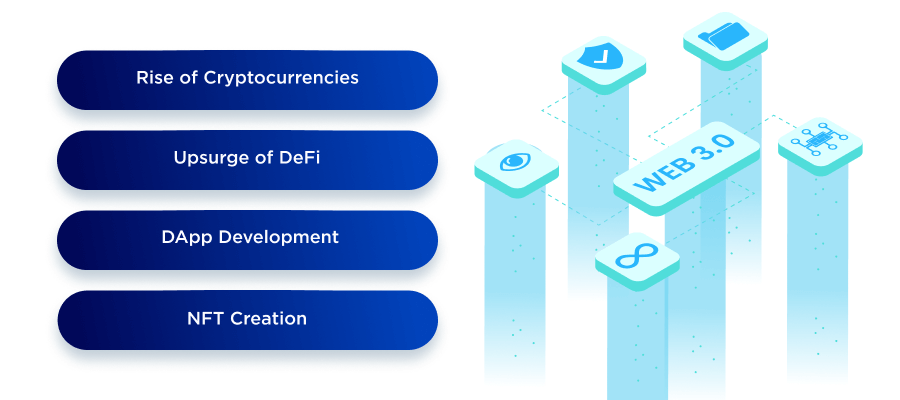Ever since the Internet and the World Wide Web burst into our lives, businesses have been on the hunt for ways to leverage these technologies to their utmost potential. Company websites were quickly developed, web-based software was acquired, and the online presence of many organizations gradually expanded.
Yet, just like with any innovation, there were also skeptics who thought that it was only a matter of time before the Internet would fade away and things go back to the way they were. Looking back, we can see how that assumption was faulty.
Now, in 2023, a new transformation seems to be brewing. Everyone’s discussing Web 3.0 and how it’ll affect the online realities we’ve all grown accustomed to.
“Success depends upon previous preparation, and without such preparation there is sure to be failure.”
— Confucius
Since preparation is key for success, it’s important for business leaders to understand how the rise of Web 3.0 and blockchain technology, which serves as its foundation, can impact their companies. After all, if you’re informed and prepared — you can quickly capitalize on the opportunities the innovation will provide. Hence, in today’s post, we’ll talk about all these nuances and share with you some examples of how companies can leverage Web 3.0.
Development of Web 3.0

Before we dive into the nitty-gritty details of what Web 3.0 means for business, it’s worth looking over its predecessors — Web 1.0 and Web 2.0.
As you may guess, everything started with Web 1.0. This original version of the World Wide Web had a read-only format and provided no opportunity for peer-to-peer interaction or communication between the readers and the content producers. Thus, Web 1.0 only delivered information to users and didn’t give them any voice. Static websites without any interactivity are the perfect example of what was present in the Web 1.0 era.
Find out How to Develop an Excellent Website
Then came Web 2.0, which is basically the current state of the internet. It ushered in a myriad of opportunities for users to interact with businesses and among themselves. Thus, enabling higher levels of participation, collaboration, and information sharing.
Social media platforms, dating apps, blogs, streaming services, business-focused web solutions, and tons more flooded the market and created the online world that we know today. Businesses gained the opportunity to have a direct line of communication with their customers, analyze their behavior, and make the most of the data that was being generated.
Discover how Velvetech Developed an Innovative Dating App
Now, it seems like we’re nearing yet another transformation. With the spread of blockchain technology, Web 3.0 has become a buzzword that has proliferated business circles.
As users started looking for ways to take control of their data, protect their identity, and feel safer while interacting online, the need for decentralization became apparent and ushered in discussions about Web 3.0.
So, what is Web 3.0? In short, it is predicted to be an intelligent version of the internet that leverages the power of blockchain, big data, and artificial intelligence to increase the level of security and safety of personal data.
Learn how Blockchain Protected a Startup from Security Breaches
For ease of understanding, take a look at the following differences between the three versions of the World Wide Web:
Web 1.0 |
Web 2.0 |
Web 3.0 |
|---|---|---|
| Primarily read-only | Read and write abilities | Read, write, and execute abilities |
| Limited interaction between web users and websites | Users can interact among each other and with businesses | Interactions between users and machines on a decentralized infrastructure |
| Data is owned by the network | Data is owned by the network | Individuals have control over their data |
| Static content | Dynamic content | 3D graphics |
| Web forms | Web applications | DApps, smart applications |
| Banner ads | Interactive ads | Behavioral ads |
It’s important to note that the Web 3.0 technology stack is what will primarily change during the transition from Web 2.0. That is to say, end users might barely notice the initial changes because most of them will occur on the backend. However, as Web 3.0 overtakes its predecessor, chances are high that the impact will be felt by everyone who uses the technology.
Layers of Web 3.0
Before moving to the features that Web 3.0 will be going to provide us with, let’s cover its core layers and what technology stack it will likely rely on. It will help you further understand the nature of Web 3.0 and decide if it can drive value for your business in the future.
Decentralized Data Network. We’ve already mentioned decentralization above, but first and definitely the key layer will be a decentralized data network, which will allow users to own their data.
Edge Computing. While edge computing is growing in popularity and more companies use it for their operations, it will become part of Web 3.0 to push data centers out to the edge and provide more control over information.
AI and ML. Artificial Intelligence and machine learning will also be an integral part of Web 3.0 as they will provide more relevant results and personalized recommendations and deliver a better user experience.
Blockchain. This technology certainly lies at the core of the next internet version, with smart contracts bringing seamless and secure transactions. Thus, all projects that will involve Web 3.0 will be based on a blockchain environment.
Main Web 3.0 Features
Now that we’ve gone over some history, it’s time to get specific about the key features and advantages of Web 3.0. Hopefully, this will provide you with an even better understanding of what the upcoming innovation entails.

Decentralized
Once again, decentralization is at the center of Web 3.0. Unlike its predecessors, this version of the web allows for digital information to be stored across various locations at the same time. Thus, avoiding reliance on a central authority and giving the power back to the users.
Ubiquitous
Ubiquity refers to Web 3.0’s ability to be accessible everywhere, at any time. Specifically, thanks to the Internet of Things, you won’t be tied to your laptop or smartphone to surf the internet. Instead, most objects around you will become connected devices and offer the chance for information to be omnipresent.
Read our To-Do List for Launching a Successful IoT Project
Permissionless
Besides decentralization, one of the major benefits of Web 3.0 is that it’ll be trustless and permissionless. In essence, that means that participants will be able to interact without going through an intermediary and without having to get authorized by a governing institution.
AI-Powered
Finally, in Web 3.0, machines will have the ability to understand and process information just like humans do. In large, thanks to artificial intelligence, machine learning, and natural language processing technologies. Thus, creating a truly intelligent ecosystem to serve the needs of its users.
3D Graphics-Based
Web 3.0 will bring more realistic three-dimensional graphics that will replace current two-dimensional web images and videos. This will not only provide a close-to-real-life online experience for users but also drive value for many businesses.
For example, 3D design is especially beneficial for companies that operate in the e-commerce sector, real estate market, and game industry. When it comes to online products and services, it’s always important for customers to know what they pay for.
Semantic-Driven
Thanks to AI and ML algorithms, we’ll see the intelligent internet that will better understand and communicate meaning and emotions by taking advantage of all accessible data. Such a semantic web will be able to decipher what data really means and provide real-world use cases.
Web 3.0 Implications for Business
In Web 3.0, pretty much everything is based on blockchain and functions thanks to smart contracts that get executed when a set of predefined criteria are met. Thus, eliminating the need for middlemen. It is precisely this capability that has multiple business implications, but there are also others. Below, we’ll cover the top four you should be aware of.

Rise of Cryptocurrencies
First and foremost, Web 3.0 will give a big boost to cryptocurrency development. Companies will either rush to create their own coins or choose to embrace existing ones and accept them as payment methods.
Since Web 3.0 will usher in the desire for decentralization, anonymity, and security — crypto will likely become the currency of choice for many people. This is because cryptocurrencies not only eliminate the middlemen and the associated transaction costs but also help speed up payment processing, allow for personal data discreteness, and keep everything encrypted for higher levels of security.
Thus, as the realities of Web 3.0 approach us, it’s worth looking into the development of blockchain-based coins or tokens that can help your business prosper within the web of the future.
Find out how Velvetech helped build a secure Cryptocurrency Mining Browser
Upsurge of DeFi
Decentralized finance (DeFi) is a financial technology that, just like cryptocurrencies, is based on distributed ledgers. It is primarily used to remove third parties like banks from financial transactions. In short, it allows individuals and businesses to carry out payments through peer-to-peer networks without going through intermediaries.
You see, people are already eager to be more in control of their finances. With Web 3.0 blockchain, this will only be enhanced. Similarly, companies are also interested in having greater control over their assets. As such, more and more organizations will turn to DeFi software in order to acquire financial freedom and avoid unnecessary bottlenecks that come from dealing with middlemen.
DApp Development
Another important occurrence for business leaders to keep in mind as Web 3.0 unfolds in our world is that there will likely be an increase in DApp development.
DApps are similar to traditional software but they are developed on decentralized networks like Ethereum. They connect to the blockchain via the previously-mentioned smart contracts and avoid centralized data servers that traditional applications rely on. Thus, reducing the likelihood of downtime if any parts of the network architecture go down.
Interestingly, there are already some Web 3.0 examples of DApps. According to State of the DApps, almost 4’000 decentralized applications exist by now and a few of the top ones are within the social, DeFi, and NFT categories.
NFT Creation
Finally, the last implication of Web 3.0 technologies that we shall discuss today is creation of non-fungible tokens (NFTs). You may have heard this term recently, as NFT projects have been garnering widespread media attention. However, it may be difficult to get a grasp on what it all actually means for your company.
NFTs are an emerging form of artwork that are distributed digitally via the blockchain. All in all, they are unique digital assets that can be purchased and sold on NFT marketplaces. While individuals and companies can make money from buying and selling NFTs in the hopes of earning a profit, there are less speculative benefits that they can offer to your enterprise.
For example, more and more organizations are leveraging NFTs for fostering brand recognition and consumer loyalty. How? Well, Asics released a collection of limited-edition digital sneakers. In this case, proceeds from sales were promised to be invested in digital artists. Thus, the company not only generated media attention for itself but also highlighted its commitment to social causes.
An example that’s more focused on B2B is Salesforce. Recently, the company informed employees that it is planning to release an NFT Cloud. While it remains unclear, for the time being, what exactly the company intends to do, it is evident that the interest in NFTs is rising across all business sectors.
So, if you’re looking to increase brand awareness, create a loyal community, foster a positive image, and generate interest in the products or services that you offer — consider looking into the world of NFTs.
Challenges of Web 3.0 Adoption for Businesses
As with any new or upcoming technology, Web 3.0 will have its challenges to consider. Thus, it’s a good idea to go through them and know in advance how they will affect businesses and what to expect.
First, Web 3.0 will put greater pressure on companies in terms of digital transformation. Since it incorporates a range of advanced technologies, companies will have to keep up with them and modernize their web solutions to support all the features of the next internet version.
Another difficulty we’ll likely face is the lack of proper regulations and rules to control Web 3.0. Due to its decentralized nature, there should be a set of policies to monitor how data is used.
Lastly, software development companies will need to manage the learning curve and adapt to new technologies while providing their web development services.
Get Your Business Ready for Web 3.0
As individuals and companies across the world ponder what exactly Web 3.0 will look like, some are already getting busy preparing for it and testing various innovations. From cryptocurrencies to NFTs, there is a multitude of ways for you to dip your toes with emerging technologies and get ahead of the competition.
Of course, getting started can seem daunting. Yet, the desire to be prepared for the new era of the Internet is powerful. For that reason, our team is proud to offer an extensive range of Web 3.0-friendly blockchain development services like building crypto or DApps. If you want to leverage DeFi or prefer to jump on the NFT bandwagon — we’ve also got you covered. So, don’t hesitate to reach out to Velvetech and begin your digital disruption journey.






























